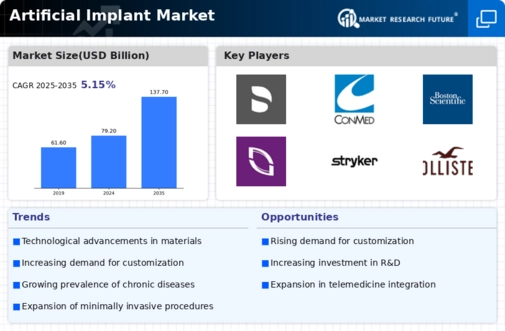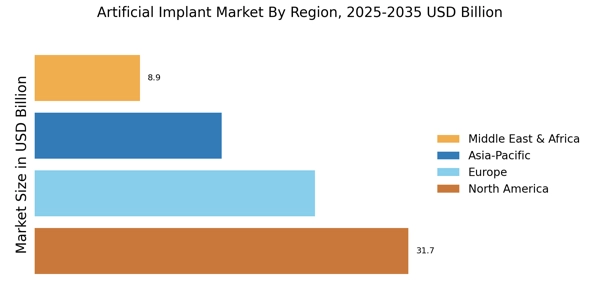Rising Aging Population
The increasing aging population is a pivotal driver for the Artificial Implant Market. As individuals age, they often experience a decline in health, leading to a higher prevalence of chronic conditions that necessitate surgical interventions. According to recent statistics, the population aged 65 and older is projected to reach 1.5 billion by 2050, which indicates a growing demand for artificial implants. This demographic shift is likely to propel the market forward, as older adults are more prone to conditions such as osteoarthritis and cardiovascular diseases, which often require implants for treatment. Consequently, the Artificial Implant Market is expected to expand significantly to meet the needs of this aging demographic.
Technological Advancements
Technological advancements play a crucial role in shaping the Artificial Implant Market. Innovations in materials science, robotics, and 3D printing have led to the development of more effective and durable implants. For instance, the introduction of biocompatible materials has improved patient outcomes and reduced the risk of complications. Furthermore, the market is witnessing a surge in minimally invasive surgical techniques, which enhance recovery times and reduce hospital stays. As these technologies continue to evolve, they are likely to drive growth in the Artificial Implant Market, with projections indicating a compound annual growth rate of over 7% in the coming years.
Growing Awareness and Acceptance
Growing awareness and acceptance of artificial implants among patients and healthcare providers significantly influence the Artificial Implant Market. Educational campaigns and improved communication regarding the benefits of implants have led to a more informed patient base. As individuals become more aware of the options available for treating various medical conditions, the demand for artificial implants is likely to rise. Additionally, healthcare professionals are increasingly recommending these solutions, further driving market growth. This trend suggests that the Artificial Implant Market may experience a robust expansion as societal attitudes towards surgical interventions evolve.
Increasing Healthcare Expenditure
Rising healthcare expenditure is another significant driver for the Artificial Implant Market. As countries invest more in healthcare infrastructure and services, the availability of advanced medical technologies, including artificial implants, increases. Data suggests that healthcare spending is expected to reach over 10 trillion dollars by 2025, reflecting a growing commitment to improving patient care. This increase in funding allows for better access to surgical procedures and implant technologies, thereby expanding the market. The Artificial Implant Market stands to benefit from this trend, as more patients gain access to necessary treatments that involve the use of implants.
Regulatory Support and Innovation
Regulatory support and innovation are vital components driving the Artificial Implant Market. Governments and regulatory bodies are increasingly recognizing the importance of facilitating the approval process for new implant technologies. Streamlined regulations and guidelines encourage manufacturers to invest in research and development, leading to innovative products entering the market. This supportive environment fosters competition and enhances the quality of available implants. As a result, the Artificial Implant Market is likely to see a surge in new offerings that meet diverse patient needs, ultimately contributing to market growth.


















Leave a Comment